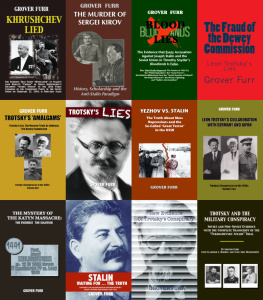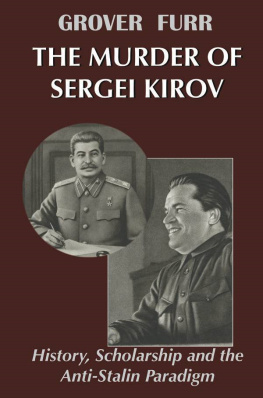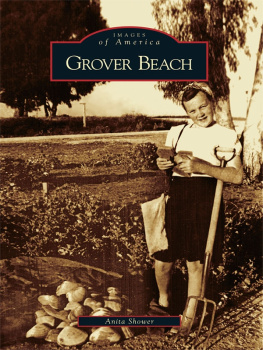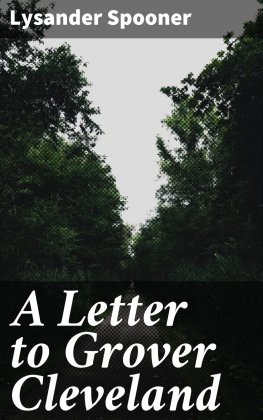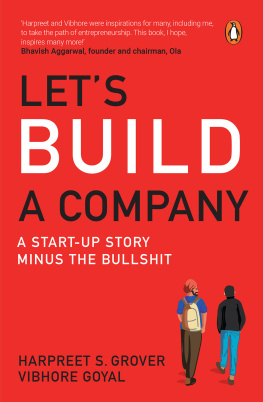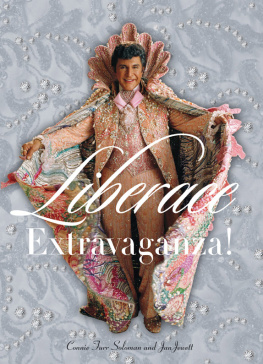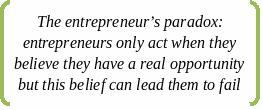Grover Furr - Grover Furr Omnibus
Here you can read online Grover Furr - Grover Furr Omnibus full text of the book (entire story) in english for free. Download pdf and epub, get meaning, cover and reviews about this ebook. year: 2021, publisher: Erythrós & Red Star, genre: History. Description of the work, (preface) as well as reviews are available. Best literature library LitArk.com created for fans of good reading and offers a wide selection of genres:
Romance novel
Science fiction
Adventure
Detective
Science
History
Home and family
Prose
Art
Politics
Computer
Non-fiction
Religion
Business
Children
Humor
Choose a favorite category and find really read worthwhile books. Enjoy immersion in the world of imagination, feel the emotions of the characters or learn something new for yourself, make an fascinating discovery.
- Book:Grover Furr Omnibus
- Author:
- Publisher:Erythrós & Red Star
- Genre:
- Year:2021
- Rating:4 / 5
- Favourites:Add to favourites
- Your mark:
- 80
- 1
- 2
- 3
- 4
- 5
Grover Furr Omnibus: summary, description and annotation
We offer to read an annotation, description, summary or preface (depends on what the author of the book "Grover Furr Omnibus" wrote himself). If you haven't found the necessary information about the book — write in the comments, we will try to find it.
Grover Furr Omnibus — read online for free the complete book (whole text) full work
Below is the text of the book, divided by pages. System saving the place of the last page read, allows you to conveniently read the book "Grover Furr Omnibus" online for free, without having to search again every time where you left off. Put a bookmark, and you can go to the page where you finished reading at any time.
Font size:
Interval:
Bookmark:
By Grover Furr
Erythrs Press and Media, LLC, 2012
Corrected Edition, November 2013
The Murder of Sergei Kirov: History, Scholarship and the Anti-Stalin Paradigm
First English Edition 2013
Published in Russian by Izdatel'skii Dom "Russkaia Panorama" in 2013 under the title Ubiystvo Kirova. Nove rassledovanie.
Published by
Erythrs Press and Media, LLC
PO Box 291994
Kettering, Ohio 45429-0994 USA
Grover Furr 2012, 2013
Published and printed with permission of the author, who assumes all responsibility for the content herein.
Locally Assigned LC-type Call NumberDK268.K5 F87 2013
Furr, Grover C. (Grover Carr)
The Murder of Sergei Kirov: History, Scholarship and the Anti-Stalin Paradigm / Grover C. Furr; translations by Grover C. Furr
ISBN: 978-0-615-80201-5
434 p. Includes index.
1. Kirov, Sergei Mironovich, 1886-1934. 2. Revolutionaries Soviet Union. 3. Stalin, Joseph, 1879-1953. 4. Soviet Union Politics and government 1917-1936. 5. Soviet Union Politics and government 1936-1953. 6. Soviet Union Politics and government 1953-1985. 7. Russia Politics and government. I. Title.
Once again, I would like to express my continuing gratitude to Kevin Prendergast and Arthur Hudson, Inter-Library Loan librarians at Harry S. Sprague Library, Montclair State University.
Their tireless efforts to obtain hard-to-find articles and books in many languages make my research possible.
*****
I dedicate this book to Susana Magdalena Sotillo, Ph.D., dedicated scholar and teacher, incisive and supportive critic, mi compaera y mi camarada, with all my love and respect.
Without your encouragement and support this work would never have been undertaken.
Egge: Egge, Osmund. Zagadka Kirova. Ubiystvo, razviazavshee stalinskii terror. Moscow: ROSSPEN, 2011.
Kirilina: Kirilina, Alla. Neizvestnyi Kirov. St Petersburg: "Neva"; Moscow: "Olma-Press", 2001.
Lenoe: Lenoe, Matthew. The Kirov Murder and Soviet History. New Haven: Yale U.P. 2010.
Lubianka 1922-1936: Lubianka. Stalin i VChK-GPU-OGPU-NKVD. IAnvar' 1922 dekabr' 1936. Moscow: IDF, 2003
Lubianka 1937-1938: Lubianka. Stalin i Glavnoe Upravlenie Gosbezopasnosti NKVD. 1937-1938. Moscow: "Materik", 2004.
RKEB 1: Reabilitatsiia: Kak Eto Bylo. Mart 1953 Fevral' 1956 gg. Dokumenty Prezjdiuma TsK KPSS i Drugie Materialy. Moscow: Mezhdunarodniy Fond "Demokratiia", 2000.
RKEB 2: Reabilitatsiia. Kak Eto Bylo. Febral' 1956 nachalo 80-kh godov. T. 2. Moscow: "Materik", 2003.
RKEB 3: Reabilitatsiia. Kak Eto Bylo. Seredina 80-kh godov 1991. Dokumenty. T. 3. Moscow: "Materik", 2004.
R-PP: Reabilitatsia: Politicheskie Protsessy 30-x 50-x gg. Moscow: Izdatel'stvo politicheskoi literatury, 1991.
The basic facts have never been seriously disputed. At about 4:30 p.m. on December 1, 1934 Sergei Mironovich Kirov, First Secretary of the All Union Communist Party (Bolshevik)1 of Leningrad oblast' (province) and city, entered the Smolny Institute, headquarters of the Bolshevik Party. Kirov mounted the stairs and walked along the corridor of the third floor towards his office. Leonid Vasil'evich Nikolaev, an unemployed Party member, was standing in the hallway. Nikolaev allowed Kirov to pass by and then rushed towards him from behind, took out a pistol, and shot Kirov in the back of the skull. Nikolaev then tried to shoot himself in the head but missed and fell in a faint on the floor a few feet from Kirov's body.
1 In Russian the Party's title was "VKP(b)" (Vsesoiuznaia Kommunisticheskaia Partiia (bolshevikov)), or "All-Union Communist Party (bolshevik)"; informally, it was still referred to as the "Bolshevik Party", "Bolsheviks", etc.
Nikolaev was seized on the spot. From this point on there is little agreement.
Either late that night or sometime the next day his interrogations began. At first Nikolaev seems to have claimed that he had killed Kirov on his own, without any accomplices, in order to draw attention to what he felt was unfair treatment of himself. Within two or three days he began to hint that others were involved. Before a week was out Nikolaev had admitted that he was part of a conspiracy by a clandestine group of Party members opposed to Joseph Stalin and favoring Grigorii Zinoviev, Leningrad First Secretary before Kirov.
NKVD investigators now turned their attention on this group. Interrogations of those Nikolaev had named, and then of the persons named by those men, led to a number of partial and a few fuller confessions. Three weeks after the murder fourteen men were indicted for conspiracy to kill Kirov. They were tried on December 28-29, convicted, and executed immediately. Meanwhile, Nikolaev's brother Piotr and wife Mil'da Draule had made more and more self-incriminating confessions. In March 1935 Draule was tried, convicted, and executed.
*****
The larger significance of the Kirov murder unfolded only gradually during the next three years. The threads that bound the Kirov conspirators to Zinoviev and Kamenev, followed up by NKVD investigators, led to the three Moscow "Show Trials" of 1936, 1937 and 1938, and to the trial of the military commanders known as the "Tukhachevsky Affair" of 1937. This last led in turn to the "Ezhovshchina", also known as the "Great Terror" of 1937-1938, during which some hundreds of thousands of Soviet citizens, most certainly innocent, were arrested and executed, with many others being imprisoned.
On March 5, 1953 Joseph Stalin died. Within months Nikita Khrushchev had become the most powerful leader of the Soviet Union. Before Stalin had been dead many months Khrushchev began organizing a campaign to attack Stalin. A major part of this effort was to declare that Stalin had fabricated false cases against all the defendants of the Moscow Trials and Tukhachevsky Affair.
Khrushchev hinted at these things in his famous "Secret Speech" of February 25, 1956. In the same speech he also cast doubt on the official version of the Kirov assassination. Within the party leadership Khrushchev and his men promoted the "rehabilitations" of a great many persons who had been executed during the 1930s, including some of the Moscow Trial defendants. Khrushchev and his men tried hard to find any evidence they could to prove that Stalin had been behind Kirov's murder. But they were unable to do so, and so at length settled for a story that Nikolaev had acted on his own.
The version that Stalin had caused Kirov to be killed continued to circulate, becoming widely believed both inside and outside the Soviet Union. Outside Russia the "Stalin did it" version continued for a while thanks to books by two well-known anticommunist writers: Robert Conquest, who wrote Stalin and the Kirov Murder in 1989, and Amy Knight, author of Who Killed Kirov? (1991) Both these works rely heavily on rumors and hearsay.
During the Gorbachev period another attempt was made by highly placed Party officials to promote the view that Stalin had killed Kirov. This attempt also failed due to the utter lack of evidence to support it. Since 1990 the view officially accepted in Russia has been that Nikolaev acted alone, and that Stalin "used" Kirov's murder to frame former or putative rivals, forcing them to admit to crimes they had never committed, and executing them and, ultimately, many thousands more.
In 1993 Alla Kirilina's book Rikoshet appeared. Kirilina was long the head of the Kirov Museum in Leningrad, an official government position that gave her great familiarity with Kirov, his life and his death. This study contains references to a modest number of primary sources and even reprints a few of them. In 2001 this book was republished as the third part of Kirilina's much longer study
Font size:
Interval:
Bookmark:
Similar books «Grover Furr Omnibus»
Look at similar books to Grover Furr Omnibus. We have selected literature similar in name and meaning in the hope of providing readers with more options to find new, interesting, not yet read works.
Discussion, reviews of the book Grover Furr Omnibus and just readers' own opinions. Leave your comments, write what you think about the work, its meaning or the main characters. Specify what exactly you liked and what you didn't like, and why you think so.

